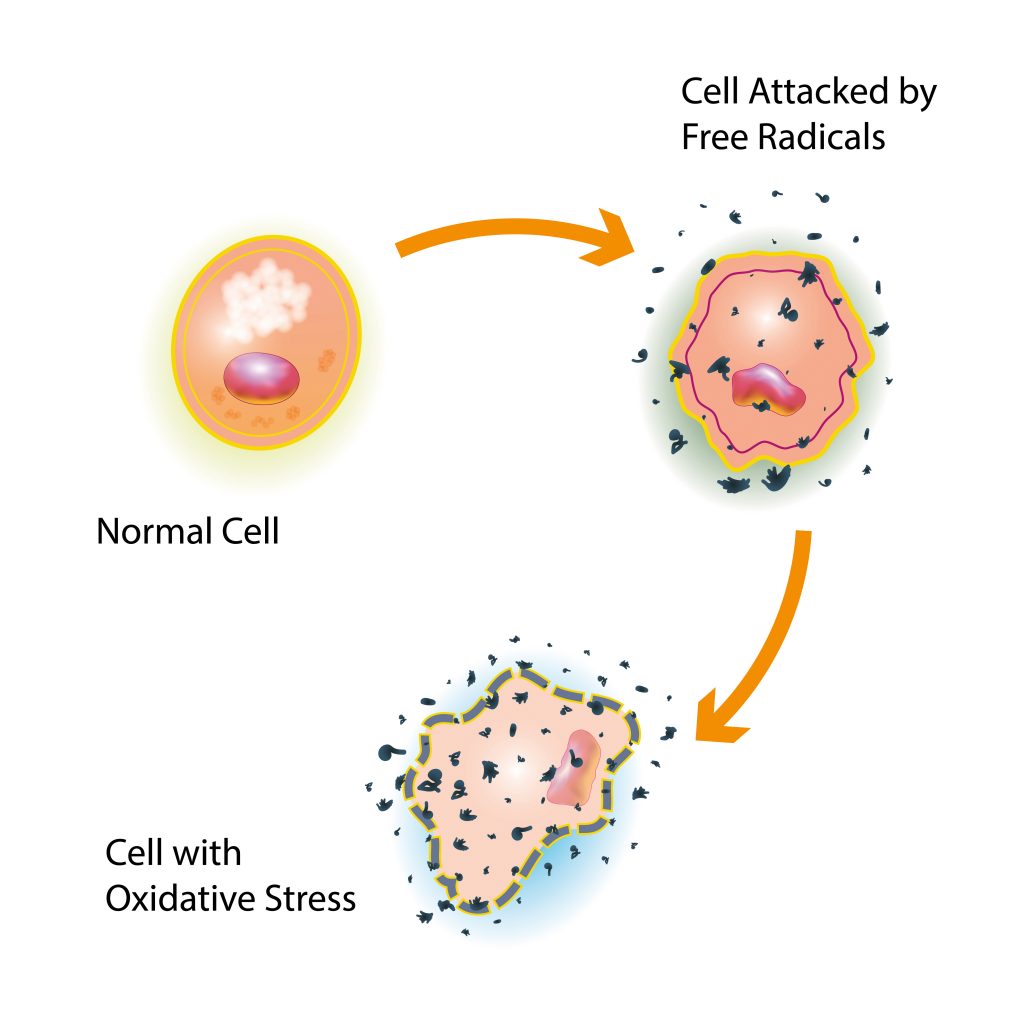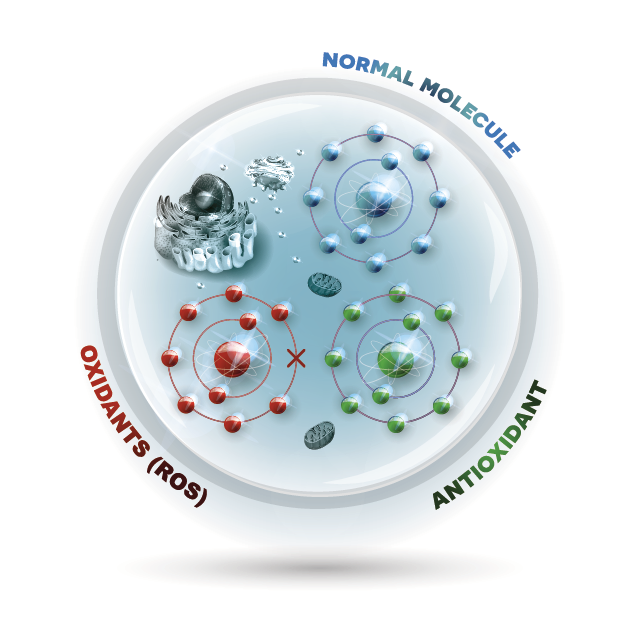Professor Marino Resendiz – Exploring the Links Between Oxidative Stress, RNA Damage and Disease
When the concentration of antioxidants and free radicals in your cells is out of balance, they experience oxidative stress. This may, in turn, result in damage to important cellular components that alter their original function, potentially having a role in the progression/development of disease. Professor Marino Resendiz from the University of Colorado Denver is researching how the modifications generated by oxidative stress alter the function and structure of RNA, an important component of all cellular organisms. His work has already demonstrated some of the changes that oxidative damage can result in, and how the oxidative modifications may potentially lead to novel structures with potential therapeutic uses.
RNA in Our Bodies
The importance of DNA and its role as genetic material is well known. However, you may not be quite as familiar with RNA, which stands for ribonucleic acid. Its structure is similar in many ways to that of DNA – they both contain units called nucleotides made up of a 5-carbon sugar, a phosphate group and a nitrogenous base. In DNA, these bases are adenine, cytosine, guanine and thymine, but in RNA the thymine is replaced with a base called uracil. Whereas DNA is found in the famous double helix structure, made up of two complementary strands (meaning the bases opposite each other always pair in the same way – cytosine with guanine and adenine with thymine), RNA is arguably more varied in terms of function, size, and molecular diversity.
RNA is a macromolecule (or biopolymer), which means that it has a large structure made up of smaller units (nucleotides). In fact, both DNA and RNA are nucleic acids belonging to one of the four macromolecules that are essential for all known forms of life to function. The others are lipids, proteins and carbohydrates.
There exist different variations of RNA in cells, but each has a specific role in the processes of transcription and translation through which new proteins are created, or in the regulation of essential biological pathways. Some examples include messenger RNA (mRNA), transfer RNA (tRNA) and ribosomal RNA (rRNA). During transcription, an enzyme called RNA polymerase reads a section of DNA and produces a complementary strand of mRNA. After leaving the nucleus where it was made, the newly formed mRNA strand finds a ribosome which decodes it in segments. Bringing in complementary tRNA fragments with amino acids bound to them allows the ribosome to piece together the amino acids and create a brand-new protein.
Through complex routes, RNA can control which genes are allowed to be turned into proteins (often referred to as ‘expressed’) as well as catalyse biological reactions, among other roles.

Oxidative Stress in RNA and Disease
One factor that can alter the structure of RNA, and hence its function, is an increase in the concentration of reactive oxygen species (ROS), some of which are free radicals. Because they are highly unstable, these molecules readily react with the biopolymers in the body, including RNA, which may cause problems for the health of a cell.
These unstable species are produced by the mitochondria as a result of metabolic activities, but they can also be generated in the body via other factors, including cigarette smoke, pesticides, and radiation, among others. Antioxidants produced by your cells usually counteract their effects, which can be enhanced or reduced by factors such as diet, pollution and radiation. An imbalance between reactive oxygen species and natural antioxidant processes is known as oxidative stress. Oxidative stress can be a positive thing – exercise causes an increase in free radicals whilst simultaneously increasing the production of antioxidants and facilitating tissue growth. However, if the body is exposed to oxidative stress over a long period of time, DNA, RNA and proteins can be damaged, leading to faster ageing and the potential for the development of a range of health issues.
Parkinson’s disease and Alzheimer’s disease are two examples in which progression is thought to be worsened by oxidative stress. Taking up about 20% of the body’s oxygen supply, the brain performs extraordinary metabolic processes, presumably creating free radicals as they occur. This can aid with new brain cell growth and consequently, cognitive function. However, an accumulation may have severe consequences. If an excess of free radicals causes cell death, these neurological conditions may be triggered.
Understandably, finding out precisely how oxidative stress can cause disease is an important area of research for many scientists. Getting to grips with the mechanisms behind disease is an essential step in the development of therapeutics and preventative approaches. One such scientist is Professor Marino Resendiz at the University of Colorado Denver, who focusses his work on the changes oxidative stress creates in RNA molecules. Furthermore, he and his research group are taking advantage of the new interactions induced by oxidation processes and using them as tools to discover novel therapeutic tools.

Oxidative Stress Alters RNA: Structure and function
Professor Resendiz and his team understood that even though oxidative stress causes up to 25 times more damage to RNA than DNA, much less research had been done on the former. The resulting oxidative damage on an RNA strand is called an oxidative lesion, one of the most common of which arises from a guanine base to create a molecule called 8-oxo-7,8-dihydroguanine (8-oxoGua). The ‘oxo’ in that long name is due to the addition of the reactive oxygen species mentioned earlier. They aimed to find out how this lesion affects the structure and function of RNA and the consequence of these changes. More specifically, they wanted to understand how the presence of 8-oxoG induces changes in how RNA interacts with other important biomolecules.
Incorporating the 8-oxoGua lesion, using chemical procedures, into pieces of RNA has allowed the Resendiz laboratory to study if it altered its thermal stability (how well it stays together under heat) and whether its function changed, i.e., how it behaves in the presence of proteins or other small molecules. Stability was either increased or decreased depending on where the lesion was added, which may have interesting implications on the role that oxidative stress has on RNA, and its potential link to disease.
The position of the lesion also had an impact on the functionality of the RNA. Its affinity (how well it attracts certain molecules) was altered, potentially changing how it interacts with other structures and proteins within cells. Professor Resendiz and his team believe their findings from this study will be useful for future research into the effect oxidative stress has on RNA, how consequent pathways are modified, and how this may present as disease. In addition, while the presence of this lesion is typically seen as a negative factor, the Resendiz laboratory is taking advantage of its unique behaviour to build new RNA constructs with novel structural and functional properties with potential therapeutic applications.

Proteins and Damaged RNA – Ribonucleases
One group of proteins whose relationship with RNA might be changed after oxidative damage is known as ribonucleases. These enzymes are part of a family called nucleases, which cut up nucleic acids, like RNA, into smaller pieces. Ribonucleases are extremely important for maintaining ‘healthy’ RNA and if they are unable to recognise damaged strands, it may go unnoticed and cause the synthesis of faulty proteins. So, in a recent study, Professor Resendiz and his team set out to test RNA containing the same lesion as before (8-oxoGua) with three different ribonucleases.
Their interesting discoveries gave a novel insight into how damaged RNA is handled by these enzymes. One ribonuclease did not recognise the lesion at all, while another not only recognised but cleaved (cut) that area. This means that some damaged RNA will be degraded and put out of action, but others may not and go on to cause problems. Ongoing work in the Resendiz laboratory focuses on exploring these interactions with other ribonucleases, while aiming to understand their biological implications.
Proteins and Damaged RNA – Reverse Transcriptases
Certain viruses produce and utilise an enzyme called reverse transcriptase to replicate within their host. All of their genetic material is in the form of RNA, so they use reverse transcriptase to read their genes backwards, creating DNA to be inserted into the host’s genome. In this way, the host unwittingly uses their own machinery to replicate and reproduce the virus that is infecting them. A couple of well-known examples of reverse-transcribing RNA viruses are hepatitis B and the human immunodeficiency virus (HIV).
Further work by Professor Resendiz investigated how oxidative damage and consequent lesions might respond to these viral enzymes. In addition to studying alterations caused by oxidative stress, they also looked into another common change that can happen to RNA in cells – the formation of inosine. When a sugar and adenine group (adenosine) lose an amine group, a new nucleotide called inosine is formed.
Professor Resendiz and his team outlined small molecular differences caused by these modifications that could have an impact on the way reverse transcriptase works on viral RNA and consequent infections. Their work will be useful as a reference for future studies into the topic, especially those studying viral biological pathways.

8-OxoG as a Novel Building Block in Aptamers
Aptamers are small pieces of RNA with a high affinity towards specific molecules. These occur naturally in biological systems and have been proposed as potential replacements of antibodies, and as powerful therapeutic agents and drugs. The current pieces used in the design of these constructs use nucleotides G, U, A, and C. The Resendiz team recently reported on the incorporation of 8-oxoG as a new building block to expand on the range for these constructs and to obtain aptamers with affinities towards different, biologically important, targets. They recognised that, while 8-oxoG can have a negative biological impact, it also offers distinct structural properties that can potentially be exploited in this context.
And There’s More to Come
Professor Resendiz has made great progress extending our knowledge of how oxidative stress changes both the structure and the function of RNA. Better understanding these intriguing biological mechanisms of life and disease is important for future research and may even aid the development of therapeutics. Continuing his work at the University of Colorado Denver, Professor Resendiz will venture to delve even deeper into these processes.
Reference
https://doi.org/10.33548/SCIENTIA628
Meet the researcher

Associate Professor Marino J. E. Resendiz
University of Colorado Denver
Denver, CO
USA
Professor Marino J. E. Resendiz graduated from the University of Utah in 2003 with a Bachelor of Science in chemistry. He went on to complete his PhD in organic chemistry at the University of California Los Angeles and then completed a postdoctoral position at John Hopkins University. Currently, Professor Resendiz works as a lecturer in organic chemistry at the University of Colorado in Denver, where he also maintains a highly active research profile. His research is focused on the relationship between the structure and function of RNA modified by oxidative stress and other chemical modifications. In particular, he looks at how this RNA interacts with small molecules and enzymes and investigates how his findings may be applied to real-world therapeutics.
CONTACT
E: marino.resendiz@ucdenver.edu
W: https://clas.ucdenver.edu/marino-resendiz/
Twitter: @Resendizlab
KEY COLLABORATORS
Haobin Wang (Department of Chemistry, University of Colorado Denver)
Courtney Kiggins (Air Force Academy)
FUNDING
National Institute of General Medical Sciences – 1R15GM132816
FURTHER READING
A Skinner, C-H Yang, K Hincks, et al., Experimental and theoretical rationalization for the base pairing abilities of inosine, guanosine, adenosine, and their corresponding 8-oxo-7,8-dihydropurine, and 8-bromopurine analogues within A-form duplexes of RNA, Biopolymers, 2020, 111, e23410.
MM Glennon, A Skinner, M Krutsinger, MJE Resendiz, Translesion synthesis by AMV, HIV, and MMLVreverse transcriptases using RNA templates containing inosine, guanosine, and their 8-oxo-7,8-dihydropurine derivatives, PLoS ONE, 2020, 15, e0235102.
C Kiggins, A Skinner, MJE Resendiz, 7,8-Dihydro-8-oxoguanosine Lesions Inhibit the Theophylline Aptamer or Change Its Selectivity, ChemBioChem, 2020, 21, 1347–1355.
C Herbert, YK Dzowo, A Urban, et al., Reactivity and Specificity of RNase T1, RNase A, and RNase H toward Oligonucleotides of RNA Containing 8‑Oxo-7,8-dihydroguanosine, Biochemistry, 2018, 57, 20, 2971–2983.
YJ Choi, KS Gibala, T Ayele, et al., Biophysical properties, thermal stability and functional impact of 8-oxo-7,8-dihydroguanine on oligonucleotides of RNA––a study of duplex, hairpins and the aptamer for preQ1 as models, Nucleic acids research, 2017, 45, 2099–211.

Want to republish our articles?
We encourage all formats of sharing and republishing of our articles. Whether you want to host on your website, publication or blog, we welcome this. Find out more
Creative Commons Licence
(CC BY 4.0)
This work is licensed under a Creative Commons Attribution 4.0 International License. 
What does this mean?
Share: You can copy and redistribute the material in any medium or format
Adapt: You can change, and build upon the material for any purpose, even commercially.
Credit: You must give appropriate credit, provide a link to the license, and indicate if changes were made.
More articles you may like
Dr Ralf Adam | New Technologies Shaping the Future of Oral Hygiene
Understanding the efficiency of various toothbrush technologies is essential for achieving optimal oral health. Dr Ralf Adam, who leads a dedicated team at Procter & Gamble in Germany, is keen to investigate the complexities of these technologies. His team have provided new insights into the best toothbrush types for plaque removal and the maintenance of gum health. By highlighting the importance of informed oral care decisions and ongoing investigations, this vital research works towards ensuring everyone can achieve a brighter, healthier smile.
WVU ADVANCE Center | West Virginia University Team Fosters Group-Level Equity and Inclusivity at Higher Education Institutions
Despite ongoing efforts to broaden participation in the academy, many groups remain underrepresented. More needs to be done to ensure that all faculty and students succeed in institutions of higher education. The WVU ADVANCE Center is an academic hub at West Virginia University, which provides services, events, mentorship opportunities, and other initiatives that promote the sense of belonging that leads to thriving faculty and students.
Dr Olalla Castro-Alvaredo | Measuring Entanglement: Symmetry-Resolved Entropy
Dr Olalla Castro-Alvaredo of the City University of London (UK) and her collaborators are advancing our understanding of an important phenomenon of quantum mechanical systems known as entanglement and, especially, its mathematical measures. Symmetry-resolved entanglement entropy is one such measure. Their study focuses on special quantum states which are excited with respect to a ground state. The research shows how the entanglement amongst quantum particles can be measured and assesses the contribution to the entanglement of quasiparticle excitations, particularly in the presence of additional symmetries.
Allison Balabuch – Professor Ann Brower Stahl | Bringing Archaeology to the Classroom and Beyond: The African Archaeology Review
The African Archaeology Review (AAR) journal recently celebrated its 40th anniversary. To mark this occasion, a special issue was compiled with an innovative theme: Archaeology for Education. To achieve this, the AAR editorial team assembled a group of academic researchers in archaeology with the proposition of writing articles collaboratively with educators that would make their research centred on Africa’s rich pasts accessible for use in school learning. The goal is to change the stories we tell about Africa both within and outside the continent.




